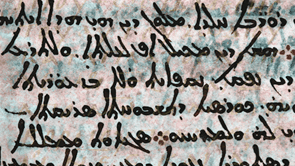Tyndale House researchers make astronomical discoveries
Codex Climaci Rescriptus
19th October 2022

Normally at Tyndale House we focus on Bible research. So in 2012, when we were asked to work on a Bible manuscript for what would become the Museum of the Bible in Washington, DC, we were glad to accept.
The manuscript, known as Codex Climaci Rescriptus, is a palimpsest—a manuscript with text which had been rubbed out and new writing placed on top. The text underneath came from around the sixth century AD, and the text on top from around the ninth.
As far as we knew back then, all the text underneath was biblical or theological and our task was to transcribe and publish it. Between 2012 and 2016 teams of summer interns worked hard to decipher what had been rubbed out. Already in 2012, Jamie Klair, then an undergraduate at the University of Cambridge, spotted that some of the erased writing was about astronomy.
These texts turned out to contain the earliest preserved sections of the Greek mathematician Eratosthenes, and some of the earliest of the Greek poet Aratus. In 2017, the manuscript was photographed using multispectral imaging by researchers at the Early Manuscripts Electronic Library in Rolling Hills Estates, California, and the University of Rochester in New York. These images uncover information in the manuscript not visible to the naked eye.
Then in 2021, during the UK COVID-19 lockdown, Tyndale House Principal, Dr Peter J Williams, was studying a page which hadn’t yet been cracked, when he realised he was seeing star coordinates. Appropriately enough, they were of Corona (Borealis).
We have been grateful to collaborate with a team from Paris, Dr Victor Gysembergh and Dr Emanuel Zingg, who have been able to explain the significance of these texts. The coordinates seem to be evidence of the lost Star Catalogue of the great Greek astronomer Hipparchus (ca. 190–120 BC), who also founded the discipline of trigonometry. They are the earliest star coordinates preserved in any manuscript.
The result is an article published in the Journal for the History of Astronomy: doi.org/10.1177/00218286221128289, as well as coverage in Nature: doi.org/10.1038/d41586-022-03296-1.